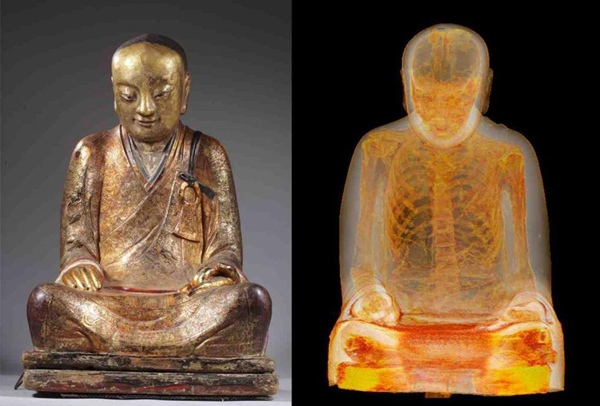Mysteries of the mummified Buddha Zhanggong
Updated: 2015-04-24 07:00
(chinadaily.com.cn)
|
|||||||||||
 |
|
A CT scan shows a body, whose internal organs were removed, concealed in an ancient Chinese statue of a Buddha. [Photos provided by the Drents Museum] |
Twenty years ago, a seated Buddhist saint – Patriarch Zhanggong– was reported missing from Yangchun village in Southeast China's Fujian province. This March, the gold-lacquered statue was discovered in the possession of a Dutch art collector in the Netherlands.
With a centuries-old smile that appeared to be radiating from inside, the eastern style Buddha impressed audiences. It also sparked questions among experts and the general public in China and overseas. How was the monk's body preserved? Who was the monk? Why is he being worshipped?
Scientific study of the Buddha
According to a 1997 examination, when the statue was removed from its base plate, a handful of dead beetles fell out together with a linen scroll inscribed with Chinese characters. Inspection revealed a number of brittle bones poking through dried skin, and the remains suggest the statue contained a mummified body of a Buddhist monk.
In 2013, the statue was taken to Germany, where a CT scan was conducted under the German Mummy Project. The result showed that inside was a perfectly mummified body, with the entrails removed.
"There was also some tissue like stuff where the lungs would have been and we suggested they had been preserved, but they turned out to be paper with Chinese characters," said Vincent van Vilsteren, curator of archaeology at the Drents Museum.
Carbon-14 radioactive isotope dating showed that the Buddha died between 1022 and 1155, proving that the Buddha had lived during the Song Dynasty (960-1297). It was also estimated that the monk died in his 30s or 40s.
Erick Bruijn, an independent researcher on Tibet, Zen and other aspects of esoteric Buddhism, took part in a study of the mummified Buddha by the Reiss-Engelhorn Museum in Mannheim, Germany. According to Bruijn, the monk might have died of disease or an abstemious, vegetarian lifestyle.
"He obviously pined away, it might be his fasting near the end of his life to prepare for his mummification," Bruijn said. "Given that such an abscess develops slowly, the monk must have suffered excruciating recurring pains over a long period of time".
Some monks would live on dried linseed biscuits and yellow wax beans only, which implied that after two years they tend to be near death and would have skin as tough as leather. This is how mummified monks were preserved.
Related Stories
Record Buddha statue on display in Shanghai 2015-04-23 16:06
Chinese authorities contact Dutch collector of stolen Buddha 2015-04-17 14:39
Why return of mummified Buddha matters 2015-04-16 14:46
Peaceful protest staged in Hungary for return of mummified Buddha 2015-04-13 17:13
World's largest reclining Buddha statue in Jiangxi 2015-04-01 07:00
Today's Top News
China and Russia to start search for Soviet soldiers' remains
Kim likely to visit Russia in May for war victory ceremony
Specialists discuss hot topics in China-EEC relations
Europe gaining importance in China's foreign investment
EU leaders to restore rescue operations after migrant boat disaster
EU, Cuba to hold political dialogue meeting in June
Britain celebrates Queen Elizabeth II 's 89th birthday
Cuban FM visits France over relations
Hot Topics
Lunar probe , China growth forecasts, Emission rules get tougher, China seen through 'colored lens', International board,
Editor's Picks

|

|

|

|

|

|






